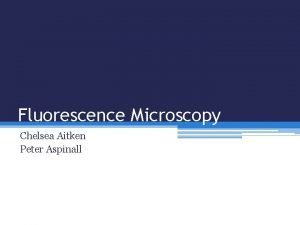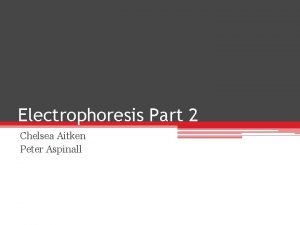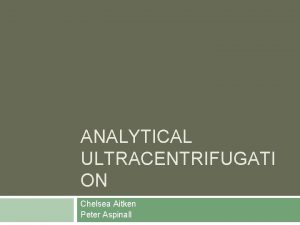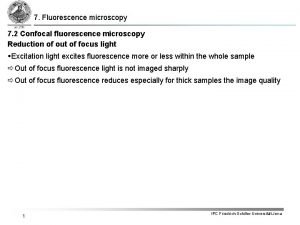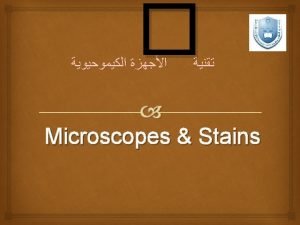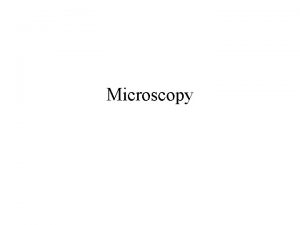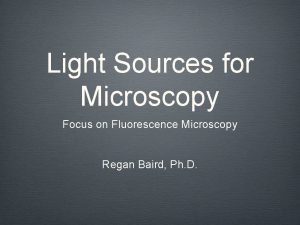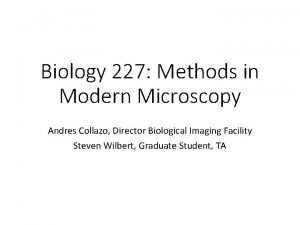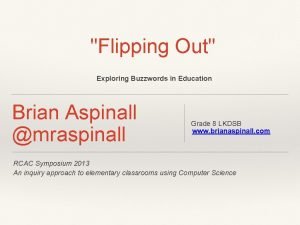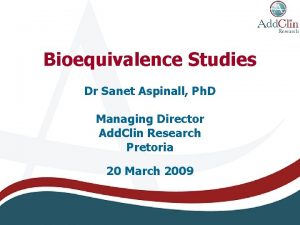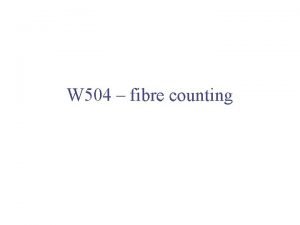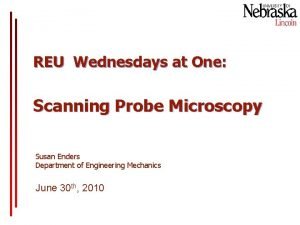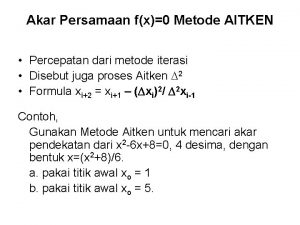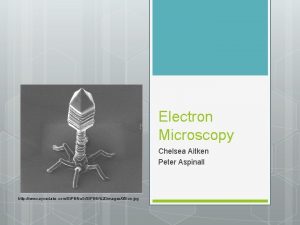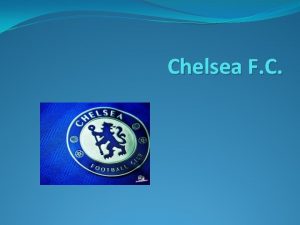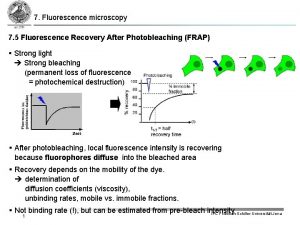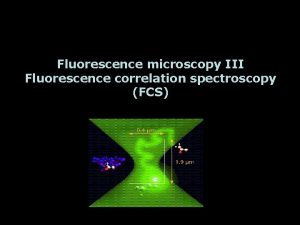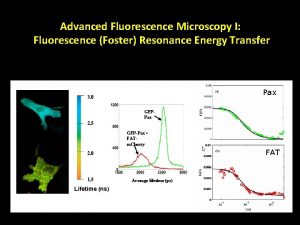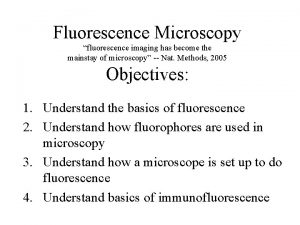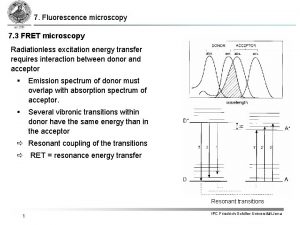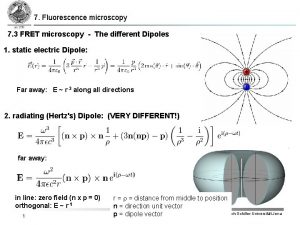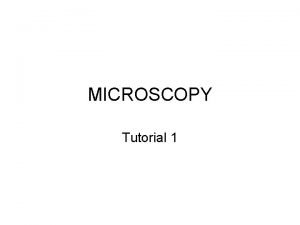Fluorescence Microscopy Chelsea Aitken Peter Aspinall Advantages Over
















- Slides: 16

Fluorescence Microscopy Chelsea Aitken Peter Aspinall

Advantages Over Light Microscopy • Resolution of light microscopy limited by Rayleigh Criterion ▫ If two objects cannot be seen as distinct structures, then they may be considered coincident in space ▫ Unable to determine whethere are molecular associations • Fluorescence microscopy can determine the distance between two molecules to 20 – 100 Å

Wide-Field Fluorescence Microscope • Molecule (fluorophore) absorbs a photon and then quickly reemits a lower energy photon ▫ Change in energy allows us to filter out incident light • Uses epi-illumination ▫ Light source goes into a filter cube and is reflected into the sample ▫ Emission returns through same objective and filter cube ▫ Because of its longer wavelength, it passes through the dichroic mirror and is read http: //upload. wikimedia. org/wikipedia/commons/4/49/Dichroic_filters. jpg

Two-Photon Excited Microscopy • Simultaneous absorption of two photons causing the fluorophore to emit a higher energy (2 x) photon ▫ Simultaneous = ~ 10 -18 s • However to generate the same number of two-photon events, the laser needs to be ~106 times more powerful than for one-photon events ▫ Use mode-locked (pulsed) lasers �Intensity at peak is great enough to cause two-photon events

Three-Photon Excited Microscopy • Three-photon events • Photon density needed is only ten times that needed for two-photon events • Useful to excite fluorophores that fluoresce at very short wavelengths (that can be difficult to produce) http: //upload. wikimedia. org/wikipedia/commons/thumb/d/d 3/Multi. Pho ton. Excitation-Fig 1 -doi 10. 1186 slash 1475 -925 X-5 -36. JPEG/1280 px. Multi. Photon. Excitation-Fig 1 -doi 10. 1186 slash 1475 -925 X-5 -36. JPEG

Total Internal Reflectance Fluorescence Microscopy (TIRFM) •

4 Pi-Confocal Microscopy • Uses two objective lens ▫ One to illuminate ▫ One to observe • This doubles the aperture angle making it possible to have an aperture angle of 4 pi • Produces clearer more detail images • Can be further improved by combining this setup with standing wave microscopy

Stimulated Emission Depletion Microscopy (STED) • Fluorophores in a small area are excited by a short pulse of light (200 fs) • Then fluorophores around this area are forced back to ground state by a second longer pulse (40 ps) • This creates a very sharp peak of fluorescence and increases resolution

Standing-Wave Illumination Fluorescence Microscopy (SWFM) •

Fluorescence Resonance Energy Transfer (FRET) •

Applications of FRET • Very useful for studying how DNA’s form changes when introduced to certain proteins • Label both ends of DNA and then can measure how the distance changes ▫ Much better at measuring changes in distance than absolute distance • Very good spectroscopic ruler for 20 – 100 Å range ▫ However cannot detect dynamic events

Green Fluorescent Protein (GFP) • Not all molecules fluoresce, so to use fluorescence microscopy they need to be fluorescently labeled • Dye molecules have to bind to specific location and not interfere with the reaction being monitored or the cell in general • Use GFP from Aequoria Victoria (type of jellyfish)

Pros/Cons of GFP • Pros ▫ When expressed is spontaneously fluorescent ▫ Doesn’t interfere with bound protein function ▫ Can target specific organelles ▫ Mutants have varying fluorescent properties • Cons ▫ Limited sensitivity ▫ Very large -> limits resolution ▫ Can undergo color changes from irradiation independent from FRET ▫ Takes hours to fold into its fluorescent shape

Applications of GFP • Conformational Sensor ▫ Uses FRET between GFP and BFP to measure distance ▫ Position varies as the bound protein undergoes structure changes ▫ Can use reemitted wavelength of light to determine distance • Cellular Reporter ▫ Can image living cells in vitro �Picture uses CFP (cyan) and YFP (yellow) ▫ Can again use FRET principles with two different dyes �Measure conformational changes when two complexes interact

Fluorescence Lifetime Imaging Microscopy (FLI) •

Sources • Serdyuk, Igor N. , Nathan R. Zaccai, and Joseph Zaccai. Methods in Molecular Biophysics: Structure, Dynamics, Function. New York: Cambridge University Press, 2007. Print.
 Chelsea aitken
Chelsea aitken Chelsea aitken
Chelsea aitken Peter aspinall
Peter aspinall Confocal fluorescence microscopy
Confocal fluorescence microscopy Compound microscope
Compound microscope Microscipe
Microscipe Light sources for fluorescence microscopy
Light sources for fluorescence microscopy Laser confocal microscopy
Laser confocal microscopy Brooke aspinall
Brooke aspinall Brian aspinall
Brian aspinall Sanet aspinall
Sanet aspinall Advantages and disadvantages of phase contrast microscope
Advantages and disadvantages of phase contrast microscope Advantages of scanning probe microscopy
Advantages of scanning probe microscopy Dianne aitken
Dianne aitken Sfzp music
Sfzp music Contoh soal metode romberg
Contoh soal metode romberg Metode aitken
Metode aitken
